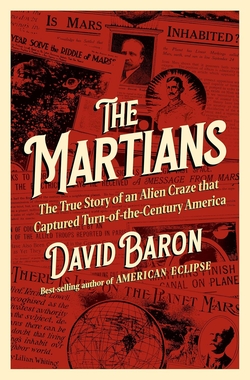Centauri Dreams
Imagining and Planning Interstellar Exploration
Crater Beneath the Greenland Ice
A crater roughly the size of the area inside Washington DC’s beltway has been found beneath the Greenland ice. On this, some thoughts, but first, a reminiscence. If you’ve ever driven the Capital Beltway at rush hour, you’ll have some sense of the crater’s size. My own experiences of it have been few, but the most memorable was the afternoon I spent at NASA Goddard Space Flight Center, where Greg Benford was speaking. We had agreed that after his talk, Greg and I would head out for dinner at a local restaurant, the exact venue to be determined later.
It was about 5:00 PM when we were in the GSFC parking lot ready to go, now joined by Gloria Lubkin, editor emerita at Physics Today. With the help of Greg’s nephew Dominic, we had chosen a French restaurant about 10 miles away. The problem: Greg and Gloria were in one car, I was in another, and it was rush hour. An out-of-towner who rarely got to DC, I was not remotely prepared for the beltway under these conditions.
I had no smartphone then, no GPS, and the only recourse was to follow the bumper of Gloria’s car. If I lost Gloria and Greg, I wouldn’t have a clue where to go. I leave it as an exercise for the reader’s imagination what it was like to be in packed lanes of high-speed traffic as night fell trying to stay close enough to the bumper ahead so as not to lose it, while simultaneously ensuring enough distance to avoid a collision. Success seemed doubtful, but we reached the restaurant together, and the meal was a gastronomic and conversational delight.

Image: Ah the Beltway. Now put all this into high-speed motion. Credit: Craig F. Walker/Boston Globe.
Greenland seems a much tamer place. The crater identified here is about 300 meters (1000 feet) deep and over 30 kilometers (19 miles) in diameter. That puts it among the 25 largest impact craters on our planet. Described in the journal Science Advances, the work was led by scientists from the University of Copenhagen’s Centre for GeoGenetics at the Natural History Museum of Denmark. The data feeding this three-year effort came from NASA.
Specifically, NASA’s Operation IceBridge was in play, an airborne mission to study polar ice using ice-penetrating radar, complemented by earlier NASA airborne missions in Greenland. Located at the edge of the ice sheet in northwestern Greenland, the circular depression under Hiawatha Glacier had never been examined, but clear evidence of its existence could be found in satellite imagery from NASA’s Terra and Aqua satellites, which showed a circular pattern.
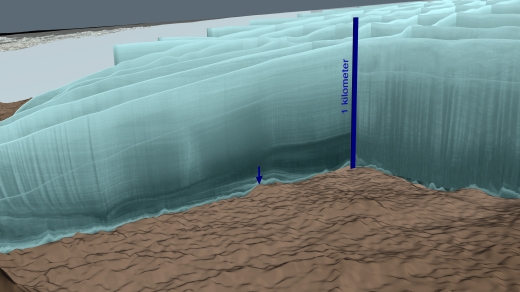
Image: Radar data from an intensive aerial survey of the Hiawatha crater in May 2016 is shown here in aqua-colored curtains. A blue arrow points to the central peak of the crater. Credit: NASA/Cindy Starr.
Subsequent radar maps made the crater’s dimensions clear. Another Beltway reference is the fact that Joe MacGregor, a NASA glaciologist at Goddard Space Flight Center, designed the later airborne mapping survey, using ice-penetrating radar from the University of Kansas. Says MacGregor:
“Previous radar measurements of Hiawatha Glacier were part of a long-term NASA effort to map Greenland’s changing ice cover. What we really needed to test our hypothesis was a dense and focused radar survey there. The survey exceeded all expectations and imaged the depression in stunning detail: a distinctly circular rim, central uplift, disturbed and undisturbed ice layering, and basal debris — it’s all there.”
You would think that glacial ice would quickly remove all trace of a crater, which is why the crater’s preservation after perhaps three million years is considered so unusual. The impactor was evidently an iron meteorite more than 0,8 kilometers (half a mile) wide. Kurt Kjær (Center for GeoGenetics at the Natural History Museum of Denmark), who is lead author on the study, believes the crater may be even younger, perhaps a remnant of an event that occurred toward the end of the last ice age. That would make it among the youngest craters on Earth.
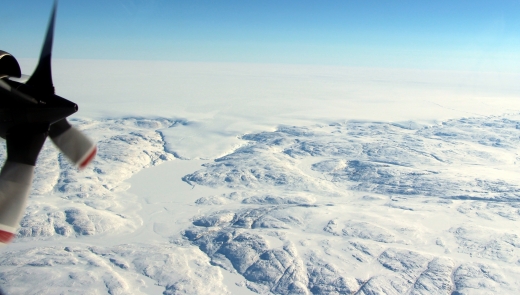
Image: The Hiawatha impact crater is covered by the Greenland Ice Sheet, which flows just beyond the crater rim, forming a semi-circular edge. Part of this edge (top of photo) and a tongue of ice that breaches the crater’s rim are shown in this photo taken during a NASA Operation IceBridge flight on April 17. Credit: NASA/John Sonntag.
The paper goes into considerable detail on the issue of the crater’s age, which remains approximate. Consider this:
The sum of these tentative age constraints suggests that the Hiawatha impact crater formed during the Pleistocene, as this age is most consistent with inferences from presently available data. An impact before the Pleistocene cannot clearly explain the combination of the relative freshness of the crater’s morphology and the ice sheet’s apparently ongoing equilibration with the presence of the crater. We emphasize that even this broad age estimate remains uncertain and that further investigation of the age of the Hiawatha impact crater is necessary. Regardless of its exact age, based on the size of the Hiawatha impact crater, this impact very likely had significant environmental consequences in the Northern Hemisphere and possibly globally.
In 2016 and 2017, researchers returned to Hiawatha Glacier to map tectonic structures and collect samples of sediments emerging from below through a meltwater channel. Here is Nicolaj Larsen (Aarhus University, Denmark), one of the authors of the study:
“Some of the quartz sand coming from the crater had planar deformation features indicative of a violent impact; this is conclusive evidence that the depression beneath the Hiawatha Glacier is a meteorite crater.”
It’s interesting to speculate on other still undiscovered impact craters under ice. They’re a reminder that the Solar System was once a violent place indeed, as the surface of our Moon indicates. There, of course, the processes of wind and water erosion could not take place, so we see stark evidence of ancient impacts. Our planet likewise had its share even if a cursory glance at the globe shows only a few, and the continuing cataloging of near-Earth objects reminds us that a defense against collisions like these is a good insurance policy for our species.
The paper is Kjær et al, “A large impact crater beneath Hiawatha Glacier in northwest Greenland,” Science Advances Vol. 4, No. 11 (14 Nov. 2018). Full text. NASA has produced a helpful video available here.

Spitzer Size Constraints on ‘Oumuamua
The first interstellar object detected in our own Solar System, ‘Oumuamua has a pleasing name, translating from the Hawaiian as something like ‘far visitor first to arrive,’ or words to that effect. It’s also proven a frustrating catch ever since detected by the University of Hawaii’s Pan-STARRS 1 telescope on Haleakala, Hawaii during a search for near-Earth asteroids. We’ve put telescope resources on Earth and in space on the object, but our observing time is up.
For ‘Oumuamua is now well on its way out of the Solar System, so we’re left to massage the data we have in hopes of gaining new insights. Davide Farnocchia (Center for Near Earth Object Studies, JPL) encapsulates the issue:
“Usually, if we get a measurement from a comet that’s kind of weird, we go back and measure it again until we understand what we’re seeing. But this one is gone forever; we probably know as much about it as we’re ever going to know.”
Thus Avi Loeb’s recent paper with Shmuel Bialy discussing the object’s acceleration in terms of solar radiation pressure — could it be a technological artifact? — and continued work on the issue of cometary outgassing to explain its anomalous acceleration. See ‘Oumuamua, Thin Films and Lightsails for the former. On the latter, we have new work from the abovementioned Farnocchia, working with lead author David Trilling (Northern Arizona University) and colleagues in a paper published in The Astronomical Journal.
Trilling and team examine data from the Spitzer Space Telescope taken in November of 2017, an analysis that shows that the object was too faint for Spitzer to detect when it began observations two months after ‘Oumuamua’s closest approach to the Sun in September of that year. That fact is itself valuable, for it sets limits on the object’s total surface area. The size issue is important, because an earlier study led by ESA’s Marco Micheli (citation below) found the object’s acceleration to be the result of outgassing, which worked, according to the team’s calculations, by assuming that ‘Oumuamua was smaller than typical Solar System comets (see ‘Oumuamua: New Data Point to a Comet).
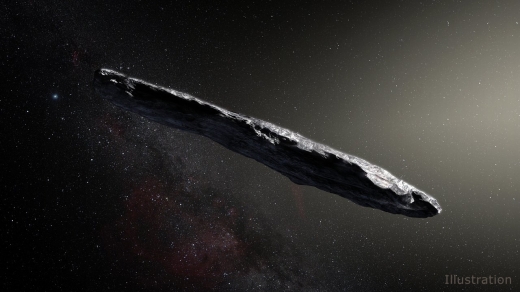
Image: Is this the shape of ‘Oumuamua? An artist’s concept of interstellar asteroid 1I/2017 U1 (‘Oumuamua) as it passed through the solar system after its discovery in October 2017. Observations of ‘Oumuamua indicate that it must be very elongated because of its dramatic variations in brightness as it tumbled through space. Credit: European Southern Observatory / M. Kornmesser.
So what constraints can we apply from the Spitzer data? Spitzer works in the infrared, adding valuable adjunct information to the variations in ‘Oumuamua’s brightness already detected by ground-based telescopes and the Hubble space instrument. These changes in brightness suggested an object less than 800 meters in its longest dimension. Unable to determine shape, the Spitzer data can only set a limit on the object’s total surface area. Thus the authors plug a spherical shape into their calculations and use three different models to reach their conclusions.
With different inputs for its composition, ‘Oumuamua’s non-detection in the infrared implies a ‘spherical diameter’ ranging from a high of 440 meters to a low of 100 meters. The results are consistent with Micheli and team’s findings on the object’s likely size assuming outgassing. Again, the range is the result of different assumptions about the object’s composition, which is unknown. This JPL news release adds that, weighing infrared findings against optical observations, ‘Oumuamua may be up to 10 times more reflective than comets in our Solar System.
A comet warms as it approaches perihelion, with ice vaporizing and cleansing the surface dust and dirt to expose more reflective ice beneath. As with comets we have observed before, outgassing can also produce a new coating of ice and snow, adding to the object’s albedo after close solar passage. This kind of outgassing could have occurred during perihelion for ‘Oumuamua about five weeks before its discovery. Did we subsequently see a dark surface with millions of years of accumulated dust being swept away by released gases and covered in new snow?
The paper is Trilling et al., “Spitzer Observations of Interstellar Object 1I/’Oumuamua,” The Astronomical Journal Vol. 156, No. 6 (14 November 2018). Abstract. The Micheli paper is “Non-gravitational acceleration in the trajectory of 1I/2017 U1 (‘Oumuamua),” Nature 559 (27 June 2018), 223-226. Abstract. The Bialy & Loeb paper is “Could Solar Radiation Pressure Explain ‘Oumuamua’s Peculiar Acceleration?” (preprint).

A Super-Earth Orbiting Barnard’s Star
The detection of a planet around Barnard’s Star really hits home for me. No, this isn’t a habitable world, but the whole topic of planets around this star has resonance for those of us who remember the earliest days of exoplanet study, which could be extended back to Peter van de Kamp’s work at Swarthmore’s Sproul Observatory in Pennsylvania. The astronomer thought he had found evidence for a 1.6 Jupiter mass planet in a 4.4 AU orbit there, based on what he interpreted as telltale wobbles in photographic plates of the star taken between 1916 and 1962.
This work, ending in the early 1970s, turned out to be the result of errors in the instrument van de Kamp was using, but the buzz about possible planets around Barnard’s Star had been sufficient to create a small crest of enthusiasm for exoplanet studies in general. The British Interplanetary Society saw in Barnard’s Star a target worth investigating, and designed their Daedalus star probe around a mission there. In any case, van de Kamp’s assumption that planetary systems were common has been proven out, and now we do have a planet around this star, though not the one that the Swarthmore researcher thought he had found.
What Guillem Anglada-Escudé (Queen Mary University, London) and Ignasi Ribas (Institute of Space Studies of Catalonia and the Institute of Space Sciences, CSIC in Spain) have uncovered is a super-Earth in an orbit near the star’s snowline. From the paper in Nature:
Here we report that the combination of numerous measurements from high-precision radial velocity instruments reveals the presence of a low-amplitude but significant periodic signal at 233 days. Independent photometric and spectroscopic monitoring, as well as the analysis of instrumental systematic effects, show that this signal is best explained as arising from a planetary companion. The candidate planet around Barnard’s star is a cold super-Earth with a minimum mass of 3.2 Earth masses orbiting near its snow-line.
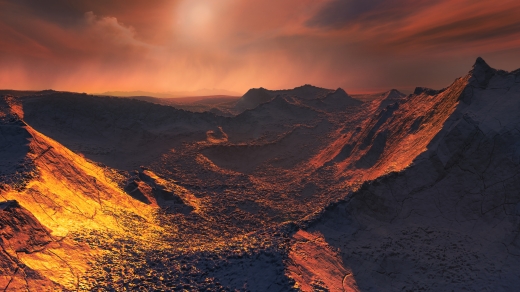
Image: An artist’s impression of the surface of Barnard’s Star b. Credit: ESO – M. Kornmesser. Licence: Creative Commons with Attribution, https://creativecommons.org/licenses/by/4.0/
Barnard’s Star b thus becomes the second closest known exoplanet to Earth (although bear in mind that the search for planets around Centauri A and B continues, as does examination of Proxima Centauri for other planets beyond Proxima b). The snow-line at Barnard’s Star, where volatiles like water can condense into solids, is close to the planet’s orbit at 0.4 AU, a reminder that the host is a red dwarf that provides but 2% of the energy the Earth receives from the Sun. The scientists believe the temperature of Barnard’s Star b would be in the range of -150 ?.
The new planet’s position in relation to the snow-line is itself interesting, as the paper notes:
The candidate planet Barnard’s star b lies almost exactly at the expected position of the snow-line of the system, located at about 0.4 au. It has long been suggested that this region might provide a favourable location for forming planets, with super-Earths being the most common planets formed around low-mass stars. Recent models incorporating dust coagulation, radial drift, and planetesimal formation via the streaming instability support this idea . Although this has yet to be shown to be part of a general trend, observational evidence would significantly constrain theories of planetary migration.
The authors point out that the Barnard’s Star work “…pushes the limits of the radial velocity technique into a new regime of parameter space,” comprising our ability to detect super-Earths in much wider orbits than ever before. Until now, such a detection would have been a matter for gravitational microlensing, with the attendant problem that such studies are inherently one-off affairs, depending on chance celestial alignments. Now we learn of a serious leap forward for radial velocity studies, one that highlights what a tricky catch this was.
Consider the range of instruments involved, among them the European Southern Observatory’s HARPS (High Accuracy Radial velocity Planet Searcher) and UVES (Ultraviolet and Visual Echelle Spectrograph) spectrographs. Says Anglada Escudé:
“HARPS played a vital part in this project. We combined archival data from other teams with new, overlapping, measurements of Barnard’s star from different facilities. The combination of instruments was key to allowing us to cross-check our result.”
All told, data from seven different instruments were put into play, a total of 771 measurements covering 18 years in a collaboration organized by the Red Dots project, which searches for terrestrial planets in warm orbits around the red-dwarf stars closest to the Sun. It was the Red Dots collaboration that was responsible for the discovery of Proxima Centauri b in 2016.
In addition to HARPS and UVES, the work included data from HIRES (High Resolution Echelle Spectrograph) at the Keck 10-meter telescope; PFS (Planet Finder Spectrograph) at the Carnegie’s Magellan 6.5-m telescope; APF (Automated Planet Finder) at the 2.4-m telescope at Lick Observatory; and CARMENES (Calar Alto high-Resolution search for M dwarfs with Exoearths with Near-infrared and optical Échelle Spectrographs) at the Calar Alto Observatory. Further observations were made with the 90-cm telescope at Sierra Nevada Observatory, the 40-cm robotic telescope at SPACEOBS (San Pedro de Atacama Celestial Explorations), and the 80-cm Joan Oró Telescope of the Montsec Astronomical Observatory (OAdM).
I don’t usually list every last instrument used in a particular detection, but I did so here because it’s a measure of what it took to find a planet of this size in a relatively cool orbit. Consider this: The data show that Barnard’s star is approaching and moving away from us at about 1.2 m/s, which is roughly the speed I make when out for my morning walk. This tiny motion detected through Doppler methods is at the heart of the new planet’s detection. The researchers note that further observations are still necessary and are underway:
“After a very careful analysis, we are over 99% confident that the planet is there, since this is the model that best fits our observations,” says Ignasi Ribas. “However, we must remain cautious and collect more data to nail the case in the future, because natural variations of the stellar brightness resulting from starspots can produce similar effects to the ones detected.”
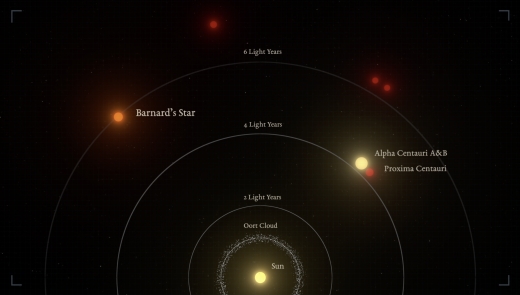
Image: Graphic representation of the relative distances to the nearest stars from the Sun. Barnard’s star is the second closest star system, and the nearest single star to us. Credit: IEEC/Science-Wave – Guillem Ramisa Licence: Creative Commons with Attribution, https://creativecommons.org/licenses/by/4.0/
Barnard’s Star is surely in our future if we reach the stage of sending instrumented probes to other stellar systems. At 6 light years, it is our closest target after the Alpha Centauri stars, and has been famous since its 1916 discovery for its remarkable proper motion of 10.3 arcseconds per year relative to the Sun. What that means is that from our perspective on Earth, this star moves faster against the background stars than any other, covering a distance equivalent to the Moon’s diameter across the sky every 180 years. In comparison to younger M-dwarfs, it is relatively quiet in terms of flare activity. Thought to be about twice the age of our Sun, it’s a reminder of our own star’s position among many stars much older than our Solar System.
The paper is Ribas, Anglada Escudé et al., “A super-Earth planet candidate orbiting at the snow-line of Barnard’s star,” Nature 15 November 2018.

Low Metallicity in Compact Multi-Planet Systems
When astronomers talk about metals, they’re using the term in a specific sense. A metal in stellar terms is any element heavier than helium. Thus iron, silicon, magnesium and carbon qualify, all elements that are components of small, rocky planets. It was iron that John Michael Brewer (Yale University), Debra Fischer and colleagues singled out as a proxy in their recent work on the metal content of exoplanet systems. The work focuses specifically on compact, multi-planet systems as one of several system architectures found in close orbit of a host star.
What’s interesting here is that these domains seem mutually exclusive, or almost so. Unlike our Solar System, a system with multiple planets on tight orbits can squeeze its worlds into a region as close as Mercury. Likewise near the host star, we sometimes find massive planets in close orbits, known as ‘hot Jupiters.’ Few of these have close planetary neighbors, and few compact multi-planet systems have massive planets.
And there is another distinguishing factor. Where the relatively uncommon hot Jupiters appear, they are most numerous around stars with high metallicity, whereas small worlds appear around stars with a wide range of metallicity. Do systems lighter in metals have problems creating larger planets? The jury is still out, but some studies have made an association between low metallicity and small planet formation that Brewer and Fischer now strengthen in this new work.
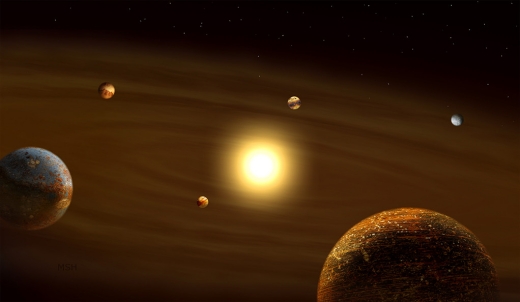
Image: Artist’s conception of a compact multi-planet system. Credit: Michael S. Helfenbein.
The researchers compared systems of a particular architecture to all known planet hosts as a function of metallicity, adding in a third architecture, systems with cool Jupiters (orbiting further than 0.3 AU from the host star). They identified in their sample 104 hot Jupiter systems, 87 cool Jupiter systems and 105 compact multi-planet systems. The latter were defined as systems with three or more planets orbiting closer than 1 AU. Note that only one hot Jupiter system is found in a compact multi-planet system, while nine cool Jupiters are found in compact systems.
The abundance of compact, multi-planet systems around stars of low metallicity that emerges is clear and points in interesting directions. Many more of these systems may exist than we have assumed. Bear in mind that such worlds are a tricky catch for radial velocity methods, but because they tend to be co-planar, they can be spotted in transit searches, which can observe transits of multiple worlds. We seem to be in a very early phase of compact system detection.
It was Fischer who demonstrated over a decade ago that higher metallicity stars were the most likely to form large gas giants, in work that supported the core accretion model of gas giant planet formation. But smaller systems have been more difficult.
“Our surprising result, that compact systems of multiple, small planets are more likely around lower metallicity stars suggests a new, important clue in understanding the most common type of planetary system in our galaxy,” said co-author Songhu Wang, a 51 Pegasi b Fellow at Yale.
Standing out in this work is the apparent connection between iron and silicon. The researchers found a high silicon-to-iron ratio in stars with lower metallicity. Moreover, low-metallicity stars are long-lived, offering older, potentially habitable worlds whose longevity may make them prime targets for astrobiology. We are likely to learn that such systems are common. From the paper:
Stars of lower metallicity and higher Si/Fe [silicon to iron] ratios are generally older or members of the galactic thick-disk population (Kordopatis et al. 2015). This could point to a changing mix of planet architectures based on formation time and location. In fact, one of the oldest verified and low-metallicity planet hosts, Kepler-444, is home to a compact multi-planet system (Campante et al. 2015). New high-precision radial velocity surveys looking for Earth-massed planets (Jurgenson et al. 2016; González Hernández et al. 2017) may find a much larger population of small planets around these lower-metallicity stars.
Fischer, in this Yale University news release, likens the ratio of silicon to iron to a “thermostat for planet formation. As the ratio increases, nature is dialing up the formation of small, rocky planets.”
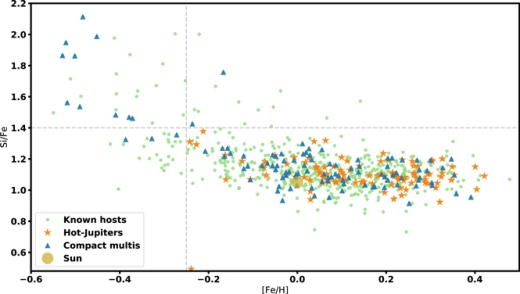
Image: This is Figure 2 from the paper. Caption: Stars with low metallicity or a high ratio of Si/Fe do not seem to form hot Jupiters, and are increasingly likely to host compact multi-planet systems. Plotted here are planet-hosting main sequence stars from our sample (green points), comparing the Si/Fe ratio to the log solar relative iron abundance, [Fe/H], with hot Jupiters (orange stars) confined to the lower right-hand side of the plot and compact multi-planet systems (blue triangles) making up a large fraction of the upper-left region. The Sun (yellow circle) is plotted for reference and the dashed lines are drawn to highlight the different populations. Stars with both high Si/Fe and high [Fe/H] are thought to be from the galactic thick-disk and are poorly represented in most planet search samples due largely to their greater distance. Credit: Brewer et al.
Exciting stuff, because we are moving into an era when new instruments like the Extreme Precision Spectrometer (EXPRES) developed by Fischer’s team at Yale, not to mention next-generation ground- and space-based resources, will make it more likely that we can find compact multi-planet systems where no transits occur.
The paper is Brewer et al., “Compact Multi-planet Systems are more Common around Metal-poor Hosts,” The Astrophysical Journal Letters Vol. 867, No. 1 (24 October 2018). Full text. Also note Zhu, “Influence of Stellar Metallicity on Occurrence Rates of Planets and Planetary Systems,” submitted to The Astrophysical Journal Letters, which likewise finds multi-planet systems more common around lower-metallicity stars (preprint).

Lucy in the Sky
Extended operations at multiple targets, as Dawn showed us, are possible with ion propulsion. But we still learn much from flybys, something New Horizons reminded us with its spectacular success at Pluto/Charon, and again reminds us as it closes on MU69. Likewise, a mission called Lucy will visit multiple objects, using traditional chemical propulsion with gravity assist to achieve flybys of seven different targets. The destination: Jupiter’s trojan asteroids. With launch scheduled for 2021, Lucy’s will study six Jupiter trojans and one asteroid in the Main Belt.
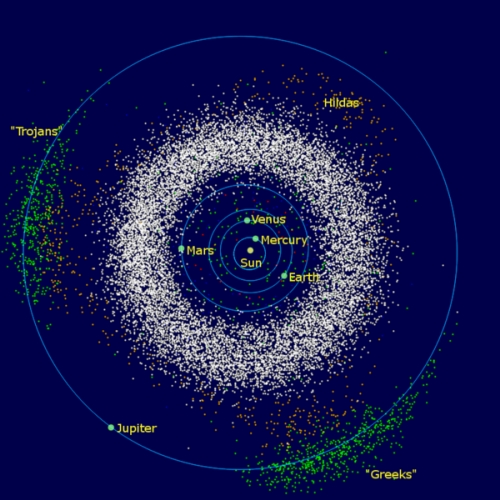
Image: Jupiter’s extensive trojan asteroids, divided into ‘Trojans’ and ‘Greeks’ in a nod to Homer, but all trojans nonetheless. Credit: “InnerSolarSystem-en” by Mdf at English Wikipedia – Transferred from en.wikipedia to Commons. Licensed under Public Domain via Commons.
The trojans are interesting bodies orbiting at the L4 and L5 Lagrange points 60° ahead and behind the gas giant. Jupiter’s trojans are the best known but the term is generic — Neptune has trojans, as does Mars, Uranus and even the Earth (2010 TK7). In fact, some Solar System moons themselves have trojans, as we saw recently when discussing Saturn’s moon Dione, which has the trojans Helene and Polydeuces. Saturn’s moon Tethys also has two trojans.
But as befits Jupiter’s massive size, it’s associated with over 6000 trojans already identified, and a larger population perhaps reaching as high as one million objects over a kilometer in diameter. 617 Patroclus is a particularly intriguing object, a D-type asteroid thought to have water ice in its interior. This object is actually a binary, with a moon named Menoetius slightly smaller than the primary. But we have C- and P- type asteroids in these Lagrange points as well, and Lucy will give us a view of each type as it makes its way into both clusters of Trojans.
The assumption is that the Jupiter trojans are remnants of primordial planet-building material, with clues to the Solar System’s formation and possibly the origins of organic material on Earth. While C-type asteroids are primarily found in the outer regions of the Main Belt, the darker P- and D-type objects have similarities to Kuiper Belt objects beyond the orbit of Neptune. Evidently abundant in dark carbon compounds, all are thought to be rich in volatiles.
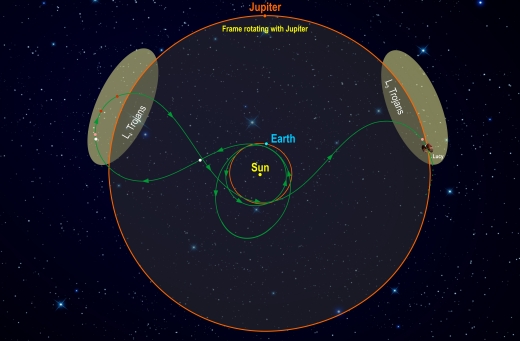
Image: This diagram illustrates Lucy’s orbital path. The spacecraft’s path (green) is shown in a frame of reference where Jupiter remains stationary, giving the trajectory its pretzel-like shape. After launch in October 2021, Lucy has two close Earth flybys before encountering its Trojan targets. In the L4 cloud Lucy will fly by (3548) Eurybates (white), (15094) Polymele (pink), (11351) Leucus (red), and (21900) Orus (red) from 2027-2028. After diving past Earth again Lucy will visit the L5 cloud and encounter the (617) Patroclus-Menoetius binary (pink) in 2033. As a bonus, in 2025 on the way to the L4, Lucy flies by a small Main Belt asteroid, (52246) Donaldjohanson (white), named for the discoverer of the Lucy fossil. After flying by the Patroclus-Menoetius binary in 2033, Lucy will continue cycling between the two Trojan clouds every six years. Credits: Southwest Research Institute.
The Lucy mission has just passed the milestone known as Key Decision Point C, a confirmation review that authorizes continuation of the project into its development phase and sets its cost and schedule. This means as well that the confirmation review panel has approved the instrument suite, budget and risk factor analysis for the overall mission. Up next comes the Critical Design Review, which thoroughly vets all aspects of the system design.
Lucy, in other words, is well on its way, says principal investigator Hal Levison (SwRI):
“Up until now this mission has entirely been on paper. Now we have the go ahead to actually cut metal and start putting this spacecraft together.”
Emphasizing the connection with the origins of the Solar System and the possible delivery of organics to Earth, PI Levison named the mission after Lucy, the fossil remains of a three million year old hominid. But he’s enough of a Beatles fan to see a connection there as well, as noted in an older quote on the mission:
“These asteroids really are like diamonds in the sky in terms of their scientific value for understanding how the giant planets formed and the solar system evolved.”
Including imaging and mapping instruments — a color imaging and infrared mapping spectrometer, a high-resolution visible imager, and a thermal infrared spectrometer — the science instrument package is similar to what flew on New Horizons and OSIRIS-REx. Lucy should reach its first targets, the L4 trojans, in 2025, followed by a return to Earth and gravity assist there to move on to the L5 trojan cluster in 2033, The craft will also make a flyby of Main Belt asteroid 52246 Donaldjohanson, which was named for the discoverer of the Lucy fossil.

Parker Solar Probe: Already a Record Setter
Over the sound system in the grocery store yesterday, a local radio station was recapping events of the day as I shopped. The newsreader came to an item about the Parker Solar Probe, then misread the text and came out with “The probe skimmed just 15 miles from the Sun’s surface.” Yipes!
I was in the vegetable section but you could hear him all over the store, so I glanced around to see how people had reacted. Nobody as much as raised an eyebrow, which either says people tune out background noise as they shop or they have little knowledge of our star.
The correct number is 15 million miles (24,1 million kilometers), and it’s still a hugely impressive feat, but I hope the station got the story right later on. I go easy on this kind of thing because it’s easy enough to make a mistake when reading radio copy (I’ve done this myself). Anyway, there is always some listener who calls it in, which I should have but didn’t. I was pushed for time that morning, making choices about squash and rutabagas and thinking about close approaches.
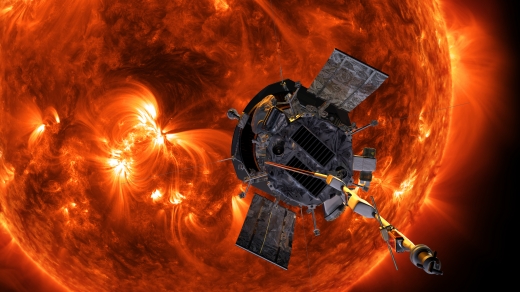
Image: Artist’s concept of the Parker Solar Probe spacecraft approaching the sun. The spacecraft will provide new data on solar activity and make critical contributions to our ability to forecast major space-weather events that impact life on Earth. Credit: NASA/JHU/APL.
After the Parker Solar Probe’s close pass, the spacecraft has gone nearer the Sun than any other craft. The Helios B probe was the previous recorder holder, setting the mark back in 1976. Helios B reached perihelion in April of 1976 at a distance of 43.4 million kilometers (26.9 million miles), inside the orbit of Mercury. A record the Parker probe surpassed with ease.
And the good news about Parker, reflected in the faces in the image below, is that the craft handled the heat and solar radiation without damage. Four status beacon signals are available, the best being the A signal that was received by mission controllers at JHU/APL on the late afternoon of November 7. Our latest mission to the Sun is live and collecting data.
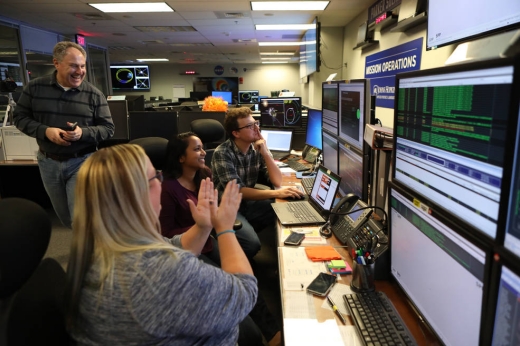
Image: Members of the Parker Solar Probe mission team celebrate on Nov. 7, 2018, after receiving a beacon indicating the spacecraft is in good health following its first perihelion. Credit: NASA/Johns Hopkins APL/Ed Whitman.
Parker is also setting speed records. Again we turn to Helios-B as the previous record-holder, at 70.2 km/s (157,078 mph). At perihelion on November 7, the Parker spacecraft reached 213,200 miles per hour, or 95.3 kilometers per second. By way of comparison, Voyager 1 moves at approximately 17 kilometers per second as it continues to push into interstellar space. Still in the heliosheath, sister spacecraft Voyager 2 is at a slightly more sedate 15.4 km/sec.
But back to the Parker Solar Probe, whose Sun-facing Thermal Protection System, an 11-centimeter thick carbon-carbon composite shield, reached about 820 degrees Fahrenheit, or 437 degrees Celsius. This is just the beginning, for the spacecraft will continue making closer and closer approaches in the course of its 7-year mission. 24 passes by the Sun are anticipated. The spacecraft will eventually close to a scorching 6.2 million kilometers from our star.
Deep space implications? The Parker Solar Probe’s findings will teach us much about the plasma flow leaving the Sun, a solar ‘wind’ that may offer future magnetic sails (magsails) one option for reaching high velocities within the Solar System (though we first must determine whether this highly variable flow can be efficiently exploited by future magsail designs).
The other implication is using a close solar pass in a ‘sundiver’ mission, accelerating a large payload that would be flung outbound in a spectacular gravitational assist, reaching velocities in the hundreds of kilometers per second. We’ll gain a great deal of knowledge about operations close to the Sun through the performance of Parker’s heat shield, all of which should be helpful if we do decide to explore sundiver options for reaching into the Kuiper Belt and beyond.

